Trends of “Energy Optimized Audit” and other services
Trends of “Energy Optimized Audit” and other services
Against a backdrop of skyrocketing prices of fuels and raw materials and approach to carbon neutrality, a great deal of attention has been given to the audit services provided by the Energy Conservation Center, Japan. The following describes various audit services, including an “energy optimized audit”. (Editorial Department)
Mr. Shunichi Akiyama, Operations Supervisor, Chief Engineer Concurrently Director of Energy Conservation Technology Division, The Energy Conservation Center, Japan
Introduction
Currently, the needs of small- and medium-sized businesses, etc. for energy audits are further increasing because of the reasons such as the skyrocketing energy prices triggered by the crude oil price, weak yen, etc. and CO2 reduction in the supply chain for carbon neutrality toward 2050. Since FY2004, the Energy Conservation Center, Japan has been conducting an energy audit project for small- and medium-sized businesses, etc. as an assistant project of the Agency for Natural Resources and Energy. It has conducted approx. 15,900 energy audits in total so far and its proposed energy-saving amount has reached approx. 710,000 kl in crude oil equivalent.
Particularly, the recent needs of small- and medium-sized businesses, etc. vary such as “What should we begin with?”, “We want to know specific measures”, “We want to know how to take energy conservation measures”. In order to respond to these needs, the energy audit project for small- and medium-sized businesses, etc. is providing not only audit schemes including an “energy optimized audit” and an “IoT audit”, but also a “self-audit tool” capable of an easy online audit.
These audits can “visualize” energy consumption and CO2 emissions of your own company, which are important to promote carbon neutrality as well as cost reduction and help you understand energy conservation measures, the first step for carbon neutrality. They are useful tools for small- and medium-sized businesses, etc. Upon application for the “energy optimized audit”, we ask applicants for the reason. Reflecting very recent situations, the most frequent reason is “cost reduction”, followed by “decarbonization and carbon neutrality”, “application for subsidy”.
The information of these audit results is widely published through an energy conservation and power-saving portal site (shindan-net.jp), etc.
2. Outline of Energy Optimized Audit
The “energy optimized audit”, the core of these audits, was updated as a new audit scheme in FY2021 by adding proposals for renewable energy, more specifically, proposals for self-consumption solar power generation equipment, to energy conservation proposals in conventional “free energy audits”. The target businesses and business establishments of the audit include small- and medium-sized businesses (those stipulated by the Small and Medium-sized Enterprises Basic Act) or the business establishments, etc. which do not fall under the category of companies mentioned in the Companies Act and their buildings, factories, etc. whose annual energy consumption (crude oil equivalent) is 100 kl to less than 1,500 kl as a rule. (For instance, hospitals, nursing care facilities, schools, municipal facilities, etc. See Fig. 1 for details.)
Although audit expenses have been partly paid by audited business operators after FY2021. The amount is approx. as low as 10,000 to 20,000, depending on the number of dispatched experts. About 90% (up to nine tenths) of total compensation for experts are subsidized by the national government.
Fig. 1 shows the target business operators of the audit and Fig. 2 shows an audit flow, etc.
The advantages of the audit include access to not only proposals for capital investment, but also those for cost-free operation improvement, and those for introduction of self-consumption solar power generation equipment, as a typical example of introduction of renewable energy, in response to carbon neutrality, an important issue in business management. In addition, if businesses take the “energy optimized audit” and apply for a national energy conservation subsidy, etc. they will have additional preferential points for subsidy examination.
The Center has approx. 400 nationally qualified experienced experts such as qualified energy managers across the country and they are registered as experts of rational use of energy. These experts go through periodic training to learn up-to-date technologies and methods.
Business operators eligible for audit
Those satisfying one of the following conditions
● Small- and medium-sized businesses (those stipulated by the Small and Medium-sized Enterprises Basic Act)
Small- and medium-sized businesses whose annual energy consumption (crude oil equivalent value) is 1,500 kl or more, except for the following
*1: (1) Small- and medium-sized business operators whose stocks are directly or indirectly possessed 100% by corporations with a capital or investment of 500,000,000 or more
This is not applied in case the corporations with the capital or investment of 500,000,000 or more are small- and medium sized businesses.
(2) Small- and medium-sized business operators whose annual average amount of taxable income exceeds 1.5 billion in each year or each accounting year of the most recent past 3 years
● Factories, buildings, etc.*3 which do not fall under the category of companies mentioned in the Companies Act and whose annual energy consumption (crude oil equivalent value)*2 is 100 kl to less than 1,500 kl as a rule
(Applicable even for less than 100 kl if low-voltage, high-voltage or extra-high-voltage power is received)
*2: Annual energy consumption (crude oil equivalent value) is calculated according to the Revised Energy Conservation Act enforced in April 2023. (Including non-fossil energy)
*3: The factories, buildings, etc. include “social welfare corporations”, “medical corporations”, “educational corporations”, “specified nonprofit corporations (NPO corporations)” and “cooperative associations other than organizations of small- and medium-sized businesses, etc.” and so on.
The audit is allowed to be conducted once for each business operator as a rule. However, it is allowed twice for the businesses (small- and medium-sized businesses) certified by the “Management Innovation Plan” implemented by the Small and Medium-sized Enterprise Agency, as a preferential treatment.
Fig. 1. Target business operators of audit (Source: Brochure of FY2024 Energy Optimized Audit Project)
Audit flow
●→ Apply for an audit menu item suitable for the usage status of electricity and fuel of the factory, building, etc. to be audited.
●→ An on-site audit is conducted in one day. Audit results are summarized in a report and their details are explained at the audit results briefing session.
Flow of energy optimized audit
Application → Sending of invoice → Payment (Confirmation of deposit) → Sending of written acknowledgment and receipt → On-site audit à Submission of report (About 1 month after audit) → Audit results briefing session (About 2 weeks after submission of report) → Information provision to energy-saving rescue team*7
Audit menu
(Note) An audit expense transfer fee, etc. shall be paid by an applicant.
| Description | Guide for annual energy consumption (Crude oil equivalent value) | Audit expense | |
| Audit A | Audit conducted by one expert | Less than 300 kl | ¥10,670 (tax included) |
|
Audit B (*4) |
Audit conducted by two experts |
300 kl to less than 1,500 kl |
¥16,940 |
| Large-scale audit | Audit conducted by two experts after pre-meeting (one expert) | 1,500 kl or more | ¥23,760 (tax included) |
*4: Even less than 300 kl, business establishments having many thermal equipment such as boilers and large air conditioners, and relatively large-scale business establishments, etc.
*5: The audit menu includes the expense for the audit results briefing session. Auditees are requested to hold the audit results briefing session as a rule from a viewpoint of improving a proposal execution rate.
*6: Auditees do not need to pay the expert’s transportation expense.
*7: The “energy-saving rescue team” is an “energy conservation support cooperative body” formed by energy conservation support business operators across the country in collaboration with local experts. Auditees will be asked in advance whether it is allowed to provide information
Fig. 2. Audit flow, etc. (Source: Brochure of FY2024 Energy Optimized Audit Project)
Energy conservation and power-saving portal site URL: https:www//shindan-net.jp/
After understanding the energy usage status of the entire business establishment, the “energy optimized audit” conducts an optimum audit and presents optimum proposals to the relevant business operator. This is one of the useful energy audits for small- and medium-sized businesses, etc. who have few energy experts within their own companies.
The “energy optimized audit” conducted by these experts is a one-day walk-through audit. It checks the energy usage status, energy management status and equipment specifications in the morning and the on-site equipment operation status in the afternoon. Then, taking approx. one month, an audit report will be prepared. The report includes energy management status, comparisons with competitors and specific energy conservation proposals. The proposals include specific energy conservation effects and cost reduction amount; for investment improvement, a rough payback period is calculated quantitatively and submitted as a reference. An audit result briefing session is held to carefully explain the details of the report to executives and type 1 energy managers in an easily understandable way.
Fig. 3 shows specific proposals for the factories and Fig. 4 those for the buildings, respectively. Common to both of them, there are more proposals for air conditioning and lighting. For the factories, there are also more proposals for production facilities, particularly compressors and boilers in the facilities.
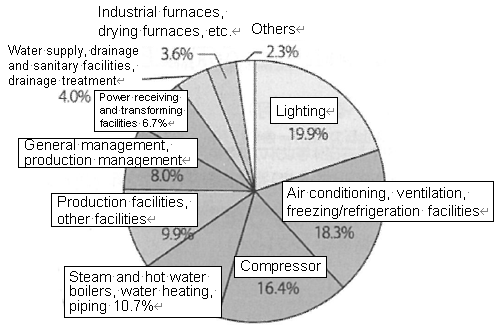
(Note) Improvement proposals by energy audit for factories
Fig. 3. Proposals for factories
(Source: Energy Conservation Guidebook for Factories 2023)
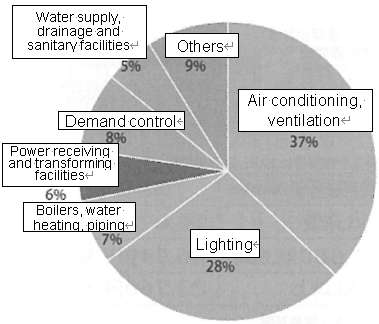
Improvement proposals by energy audit for buildings
Fig. 4. Proposals for buildings
(Source: Energy Conservation Guidebook for Buildings 2023)
Energy-saving potentials by business category
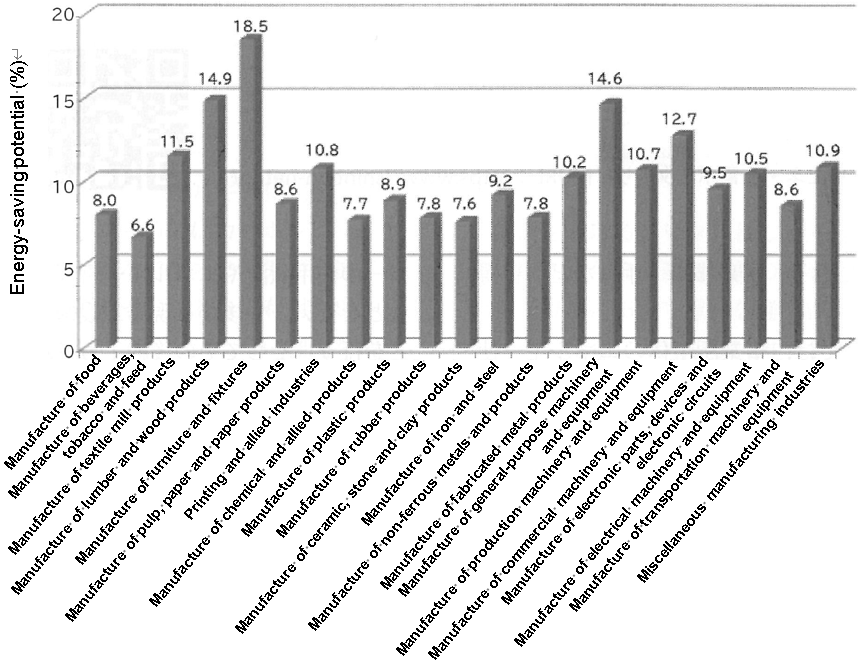
Fig. 5. Energy-saving potentials of factories
(Source: Energy Conservation Guidebook for Factories 2023)
Energy-saving potentials by purpose of use
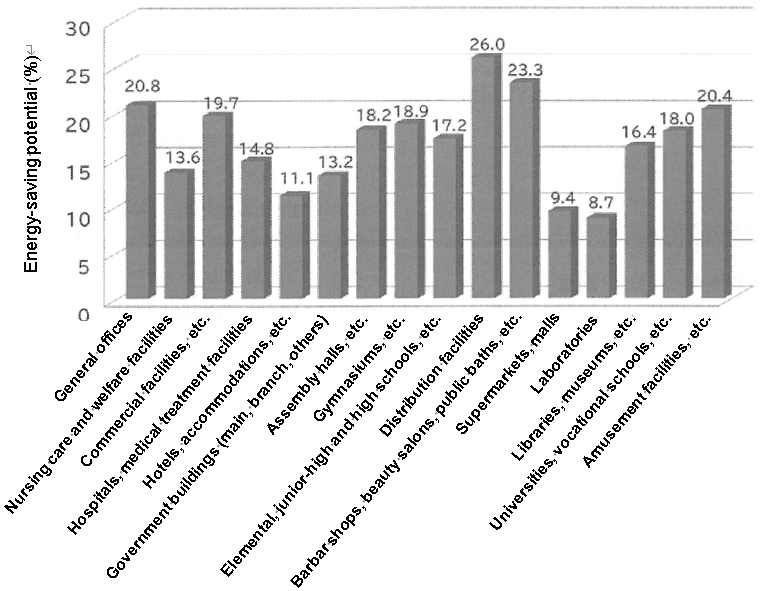
Fig. 6. Energy-saving potentials of buildings
(Source: Energy Conservation Guidebook for Buildings 2023)
3. Outline of IoT Audit
“IoT audit” is a service intended for the business operators who have taken the “energy optimized audit” and “want to practice further energy conservation”. It is conducted, accompanied by measurement, etc. as required.
The audit is available at low expense on the premise of providing a wide range of information on audit details. Specifically, it responds to the needs of “reducing fixed energy in cooperation with production processes”, “saving energy across the energy usage system”, “considering DR (Demand Response) measures”, and so on, using and analyzing detailed data to make proposals. If the audited business has no detailed data, the audit supports it, including data measurement.
Fig. 7 shows a measurement case which visualized a difference in standby power (during non-machining time) by measuring power consumption of a machine tool to lead to improvement.
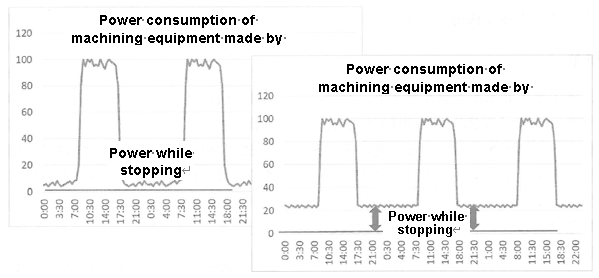
Fig. 7. Power consumption measurement example of machining equipment (Illustrated)
4. Outline of Self-audit Tool
The portal site provides a “self-audit tool” capable of presenting the energy-saving potentials of the business operators, improvement information, etc. By inputting their own energy consumption (annual power consumption and fuel consumption) as information, the business operators are capable of understanding CO2 emissions, energy-saving potentials (kl/year), reducible amount of money (yen/year) and specific energy conservation measure items (operational improvement, capital investment improvement). This information presents the proposals based on the audit results close to the business operator (business category, energy consumption, etc.), which have been analyzed and input by AI as to the proposals by the “energy optimized audits” conducted in the most recent 5 years. It also allows comparison of energy consumption with competitors.
Fig. 8 shows the home screen of the self-audit tool.
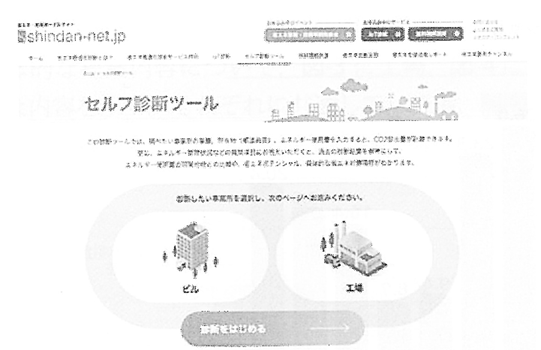
Fig. 8. Home screen of self-audit tool
Self-audit tool: https://www.shindan-net.jp/selfcheck
5. Information Provision Project
The information provision project delivers various information through the energy conservation and power-saving portal site, publication of brochures and case studies, presentation of energy audits and technological cases, energy conservation briefing session, and so on. The energy conservation and power-saving portal site, the core of these activities, publishes areas, business categories, energy consumption scales, main energy conservation proposals, etc. as to the past audit details, which are searchable. The site explains publication of energy conservation guidebooks on energy conservation technologies, audit status, operational improvement measures, etc. in an easily understandable way by means of videos.
Furthermore, the successful cases of past audited business operators are lectured at the presentation of energy conservation audit and technological cases annually held in autumn, and their details are published as energy conservation case studies and released at the portal site.
6. Conclusion
After the audit, a questionnaire is conducted with the audited business operators. The audit has been favorably reviewed by the majority of them because it was useful. Also, we have received comments from the business operators who published their cases, including post-audit energy conservation activity results.
As an example of the business operator who used a subsidy to introduce high-efficiency equipment after the audit, he says “All business owners understand that energy conservation is important to businesses from viewpoints of SDGs and cost reduction, but there are barriers to clear such as investment cost and business owner’s decision. We appreciate the energy conservation audit which gave us the possibility of using a subsidy and helped us make a decision.” For the business operators having multiple factories, many of them have had other factories audited in the following fiscal years after having the first one audited.
Furthermore, we ask upon application how they got information on the “energy optimized audit”. Many of them reply that they got to know through the Center’s website and portal site or through references by municipalities. Recently, however, there have been more references by local financial institutions in addition to those by chambers of commerce and societies of commerce and industry. It is expected that there will be a continuous increase of applications in the future through references by these local bodies which have been associated with management of small- and medium-sized businesses on a regular basis.
In FY2024, about 540 audits are scheduled. Acceptance of applications started on April 18, already accepting them from many business operators as with last year and the year before last.
If you are interested in the “energy optimized audit”, please apply for it early.

